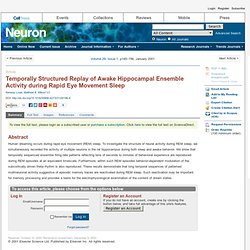

Dreams. Sleeping/Dreaming. Lucid Dreaming. By lucid dreaming, you can gain complete control over the one place that no one will ever care about: your imagination.

Just The Facts Lucid dreaming is a scientifically proven phenomenon. While some get into lucid dreaming in order to treat chronic nightmares, or to experience all facets of the human experience, approximately 99.8% of people use it as a tool for cheap and interactive 3D porn. A lucid dream is a dream in which the dreamer is aware that he or she is dreaming, and he or she can even choose to control and manipulate his or her dream. Dream, dream, dream. How to Take Control of Your Dreams: So, you've doubled your weight over the past five years, you own a record-shattering collection of greasy pizza boxes and broken aspirations, and you're beginning to consider installing a toilet bowl in the place of your computer chair? In order to even begin to get control over your dreams, there are a few preliminary tasks you must complete.
The Tasks: 1. "What? " Calm down! Hypnagogia and Hypnopompia. Hypnagogia is the imagery, sounds and strange bodily feelings that are felt at “sleep onset.”

This is a simplification though, as researchers have noted hypnagogic imagery in the lab at periods of quiet wakefulness as well as stage 1 sleep. Others have correlated hypnagogia with pre-sleep alpha waves and also REM intrusion into sleep onset. The truth is that the wake-sleep transition is still not understood. And neither are its trippy visuals. whispy lights, multi-dimentional geometric objects, or a sudden image like a stranger’s face Few people remember hypnagogic imagery. Strange noises, voices and rushing sounds are typical, as well as weird mechanistic sounds like beeps and boops. Some hear music — I personally have had lucid hypnagogic orchestras from time to time, with the ability to listen passively or focus on a particular instrument to induce a solo. Entoptica - by Ryan Hurd, 2005, acrylic: inspired by my hypnagogic imagery Some people are haunted by the hypnagogic imagery.
02.22.2010 - An afternoon nap markedly boosts the brain’s learning capacity. If you see a student dozing in the library or a co-worker catching 40 winks in her cubicle, don’t roll your eyes.

New research from the University of California, Berkeley, shows that an hour’s nap can dramatically boost and restore your brain power. Indeed, the findings suggest that a biphasic sleep schedule not only refreshes the mind, but can make you smarter. Students who napped (green column) did markedly better in memorizing tests than their no-nap counterparts. (Courtesy of Matthew Walker) Conversely, the more hours we spend awake, the more sluggish our minds become, according to the findings.
“Sleep not only rights the wrong of prolonged wakefulness but, at a neurocognitive level, it moves you beyond where you were before you took a nap,” said Matthew Walker, an assistant professor of psychology at UC Berkeley and the lead investigator of these studies. In the recent UC Berkeley sleep study, 39 healthy young adults were divided into two groups — nap and no-nap.
Neuron : Temporally Structured Replay of Awake Hippocampal Ensemble Activity during Rapid Eye Movement Sleep. To view the full text, please login as a subscribed user or purchase a subscription.

Click here to view the full text on ScienceDirect. Fig. 1 Behavioral Task and Hippocampal Unit Activity (A) Schematic of the four-trial sequence in the circular track task. A single trial consisted of travel from the start location to a removable food well placed at the goal location, followed by food consumption; in any given trial the goal was located at a position 270° clockwise from the start. (B) Spatial firing characteristics of three example CA1 cells. (C) Periodic repetition of characteristic ensemble spiking pattern. Fig. 2 Identification of REM Sleep Templates for Correlation Analysis (A) Experimental design. (B) Schematic of sliding window correlation analysis. Fig. 3 Example Correspondence between a REM Template and RUN Activity. Lucid Dream Guru - Master the Art of Lucid Dreaming. Japanese Dream Recording Machine. DREAM JOURNAL.